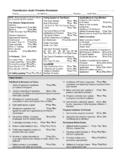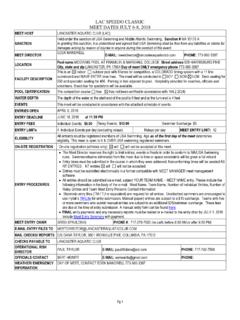Transcription of Adirondack Chair - content.wiltontool.com
1 COMPLIMENTARY WOODWORKING PLAN Adirondack Chair This downloadable plan is copyrighted. Please do not share or redistribute this plan in any way. It has been created for Wilton Tools, a division of WMH Tool Group. Tools Needed: -Jig Saw -Drill -Belt Sander (recommended) -Table Saw (recommended) -Basic Hand Tools.
2 Supreme ComfortElegant AppearanceContoured Seat & BackRigid ConstructionFolds to 10" heightSimple ConstructionFeatures:Included in Plan:Grid Diagram detailing contoured partsParts ListCutting Diagrams3D Assembly DiagramsStep by Step InstructionsFootrest Plan IncludedClassic AdirondackChair PlansD. Roy Woodcraftidea s i n wo odD en is Roy 2003 Classic Adirondack ChairD. Roy Woodcraftidea s i n woodDenis Roy 2003 Materials List QTY Length Material Description 2 10' 2 X 4 Cedar 1 7' 2 x 6 Cedar 4 6' 1 X 6 Cedar fence boards 1 5' 1 X 8 Cedar 50 1 1/2" brass Deck screws 32 3" brass Deck screws Parts List All measurements in inches Part # Dimensions QTY Description Notes #1 38 1/2 x 5 1/4 x 1 1/2 2 Sides Cut to shape per template #2 20 x 3 1/2
3 X 1 1/2 1 bottom back brace Cut from 2 X 4 #3 2 1/2 x 20 7 Seat slats rip from 1 X 6 #4 18 3/8 x 3 1/2 x 1 1/2 1 top back brace Cut to shape per template #5 24 1/4 x 2 x 4 2 back legs Cut from 2 X 4 #6 21 1/2 x 2 x 4 2 front legs Cut from 2 X 4 per template #7 3 1/2 x 3 1/2 x 1 1/2 2 front angle blocks Cut from 2 X 4 #8 3 1/2 x 1 1/2 x 1 1/2 2 rear angle blocks Cut from 2 X 4 #9 31 1/2 x 7 1/4 x 3/4 2 arms Cut from 1 x 8 #10 tapered as per step 7 1 centre slat Cut pairs from 32 x 4 x 3/4 #11 2 2nd slat #12 2 3rd slat #13 2 4th slat #14 3 x 20 x 3/4 1 rear seat slat cut to shape per template #15 14 1/4 x 2 x 4 2 footstool side cut from leftover 2 x 4 or 2 x 6 #16 12 3/4 x 2 x 4 4 footstool legs cut from leftover 2 x 4 #17 2 1/2 x 20 x 3/4 7 footstool slats rip from 1 x 6 Classic Adirondack ChairD.
4 Roy Woodcraftidea s i n woodDenis Roy 2003 Step 1: Cut out all parts as per the contour diagram. Note that the outline for part #1 has been shortened by 8" in order to fit the page. Note also that parts #2, #4, and #14 have a mirror line shown. Flip the template over along this line to make a part that is twice the length of the template. Sand the outer surfaces of the two sides (parts #1) and the bottom back brace (part #2) Place the two sides on the floor, spaced as shown.
5 Attach the bottom back brace to the sides using glue and 3" brass deck screws. Ensure the assembly is square. Step 2: Sand the outer surfaces of the seat slats, (parts #3), including the ends and the edges. Round over the edges slightly with the belt sander. Attach the slats to the sides using 1 1/2" brass deck screws, countersunk flush with the surface. Ensure that the heads of the screws all line up visually. Do not install the rearmost slat (part #14) at this point as it would get in the way later.
6 Note that these seat slats as well as the back slats are best left unglued. This greatly simplifies future refinishing, allowing the slats to be removed for power sanding. Classic Adirondack ChairD. Roy Woodcraftidea s i n woodDenis Roy 2003 Step 3: Cut the angled ends on the back legs (parts #5) as per the angle template. Sand the outer surfaces of the parts and attach the top back brace (part #4) as shown, using glue and 3" screws.
7 Step 4: Elevate the front of the Chair to a height of 13 1/2" as shown. Attach the front legs using C-clamps, Ensure the legs are straight and plumb and that the Chair does not rock. The front legs should be mounted within a couple of inches from the front edge. Although mounting them 6" from the front looks better, the Chair has a tendency to tip a bit when getting in and out of it.
8 Mount the legs permanently from the inside using two screws each. Position the back assembly as shown and mount with C-clamps. Ensure that everything is straight and square. Mount the back assembly from the inside using two screws into each support. Classic Adirondack ChairD. Roy Woodcraftidea s i n woodDenis Roy 2003 Step 5: Install the front angle blocks (parts #7) on the front legs as shown, using glue and two screws, countersunk. Using a one of the arms as a straightedge, determine the location of the the rear angle blocks (parts #8).
9 Ensure that the arm is level. Attach the angle blocks with glue and screws. When mounting angle blocks, prevent splitting by drilling a pilot hole before driving the screws. Another trick to prevent splitting is to tighten a clamp over the anticipated split area. Step 6: Install the arms as shown, using 3 screws each. Use one screw into the rear angleblock, one into the front angleblock, and one into the front leg.
10 Glue on this part is optional but I would tend to leave it out in order to make refinishing easier later. Taper Jig: Step 7: The taper jig shown is useful for cutting perfect tapered slats for parts 10, 11, 12, 13. It is made from a scrap piece of 3/4" stock cut to 38" X 4". The shape shown is cut into the centre of it in order to accept each 32" X 4" piece of slat stock. The jig is used on the table saw with the fence set to 4" from the blade.







